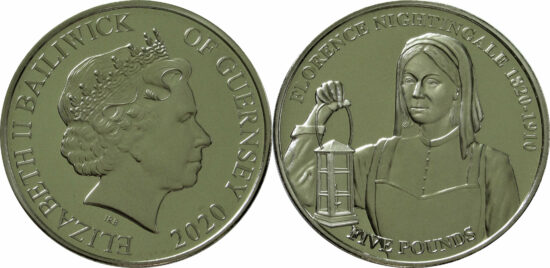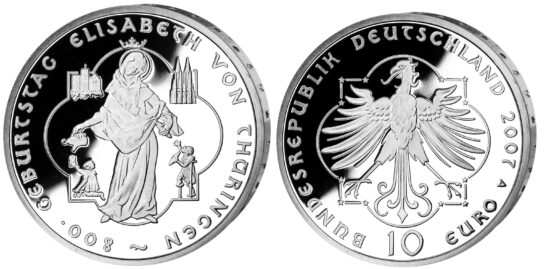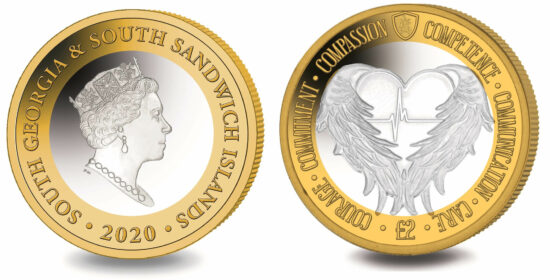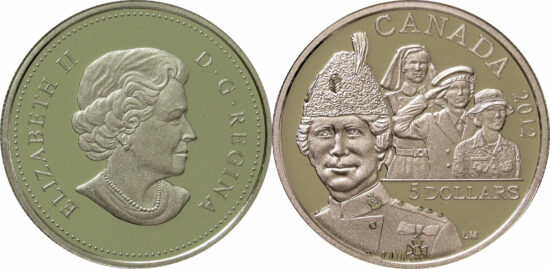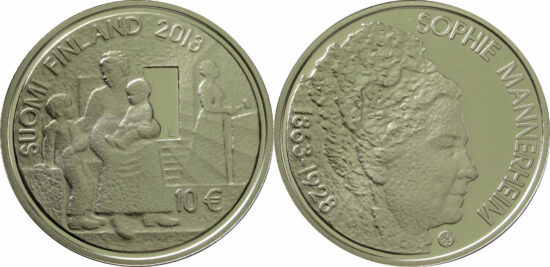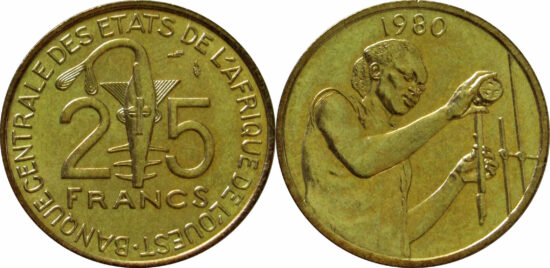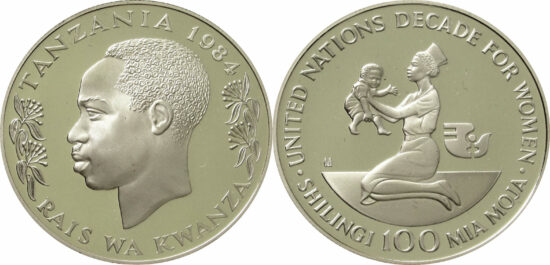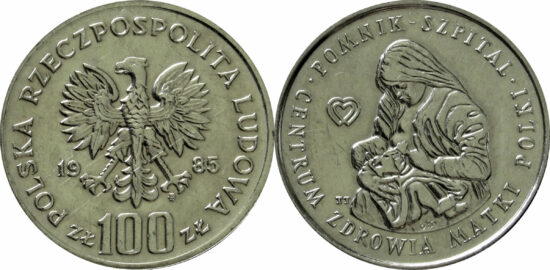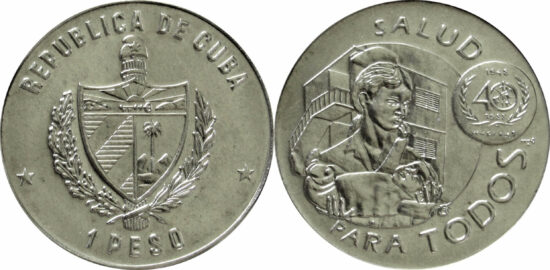Over the course of the pandemic, health care professionals have attracted increased media attention. While the latest numismatic issues feature nameless medical professionals or allegorical depictions and were clearly inspired by the current health crisis, earlier coins commemorate (famous) women in medical professions and refer to other historical or socio-political topics.
The History of Nursing
“The early history of nurses suffers from a lack of source material, but nursing in general has long been an extension of the wet-nurse function of women. Buddhist Indian ruler (268 B.C.E. to 232 B.C.E.) Ashoka erected a series of pillars, which included an edict ordering hospitals to be built along the routes of travellers, and that they be ‘well provided with instruments and medicine, consisting of mineral and vegetable drugs, with roots and fruits’; ‘Whenever there is no provision of drugs, medical roots, and herbs, they are to be supplied, and skilful physicians appointed at the expense of the state to administer them.’ The system of public hospitals continued until the fall of Buddhism in India ca. 750 CE. About 100 B.C.E. the Charaka Samhita was written in India, stating that good medical practice requires a patient, physician, nurse, and medicines, with the nurse required to be knowledgeable, skilled at preparing formulations and dosage, sympathetic towards everyone, and clean.” (Wikipedia: History of nursing, Ancient history, consulted in July 2021). Accordingly, nurses and nursing schools have been around since 250 BCE at the latest and the qualifications needed to become a nurse back then hardly differ from what was expected from nurses in Europe until well into the 19th century.
In European antiquity, there was no distinction between medicine and nursing in sanatoria – apart from the fact that tasks were assigned depending on the person’s individual level of knowledge. In private households, however, caring for family members was the task of women and slaves. With the spread of Christianity, a strong connection between nursing and the concept of Caritas, charity and benevolence evolved. This was true both within the Christian community and in hospitals for strangers and the sick.
The need for professional nursing evolved during the 18th and 19th centuries and resulted from the progress made in scientific medicine, which required an increased amount of systematically trained assistants. That is why nurses are, for example, depicted as assistants to medical researches – for instance on the 2010 Austrian 50 euro coin in honour of the founder of allergy research, Clemens von Pirquet (CoCo AT-2010-0016). Institutions that cared for anyone in need became hospitals that exclusively focused on medical care. Wars also generated an increased need for nursing stuff, which could no longer be met by the clergy alone (cf. German Wikipedia, Geschichte der Krankenpflege, consulted in March 2021).
During her work in the Crimean War (October 1853 until March 1856), the pioneer of modern nursing, Florence Nightingale, realized what it meant for her to be a true nurse and recognized the need to professionalize nursing. Based on her experience, she wrote ‘Notes on Nursing’ in 1859, a work that contains the first nursing theories and training models for professional, interdenominational nursing. In this way, she also influenced Henry Dunant, the founder of the International Red Cross and Red Crescent Movement.
Coins in Honour of Female Nurses
The following is a list of commemorative coins dedicated to nurses that are known by name (sorted according to the year of birth of the honoured). Not included are the numerous coins that were issued to honour Mother Theresa, most of them on the occasion of her receiving the Nobel Peace Prize and her beatification and canonization.
– Elizabeth of Hungary and Thuringia (Rákóczi Castle in Sárospatak 1207-1231 Marburg), Hungarian princess and Landgrave of Thuringia (Wartburg); being a supporter of the doctrine of apostolic poverty, she led a life following the apostolic ideal (poverty and chastity); after her husband’s death, she worked in the Marburg hospital, which had been funded by the inheritance she had received from her husband; she was a national saint of Germany for some time embodying the ideal of active charity
> Germany, 10 euros, 2007 (occasion: 800th birthday – CoCo DE-2007-0041)
> Hungary, 5000 forint, 2007 (occasion: 800th birthday)– Zdislava of Lemberk (after 1220-1252 at Lemberk castle in Bohemia) was married in 1238 to Gallus of Lemberk, who had the commandry and the hospital of the Order of St John built in 1240; Zdislava herself had the Dominican monastery in Gabel built, where she cared as a nun for the poor, the sick and those who suffered from leprosy
> Czechia, 200 korun, 2002 (occasion: 750th birthday)– Zsuzsanna Kossuth (Sátorújhel 1817-1854 New York), first chief nurse of the Hungarian military
> Hungary, 2000 and 10000 forint, 2017 (occasion: 200th birthday)– Florence Nightingale (Florence 1820-1910 London), English nurse, pioneer of modern nursing, founder of the first School of Nurses in 1860 in London and of a school for midwives, author of textbooks for health care professionals and nurses
> Gibraltar, 1 crown, 2001 (occasion: Victorian Age)
> Alderney, 5 and 10 pounds, 2004 (occasion: 150 years Crimean War)
> Jersey, 5 pounds, 2006 (series: Great Britons)
> Great Britain, 2 pounds, 2010 (occasion: 100th anniversary of her death)
> Guernsey, 5 pounds, 2010 (occasion: 100th anniversary of her death)
> Guernsey, 5 and 10 pounds, 2020 (occasion: 200th birthday)
> South Georgia & South Sandwich, 2 pounds, 2020 (occasion: 200th birthday – CoCo GS-2020-0012/13)– Georgina Pope (Prince Edward Island 1862-1938 Charlottetown) trained in the Bellevue Hospital in New York and served in the Second Boer War, first Canadian to receive the Royal Red Cross in 1903, first matron of the Canadian Medical Corps in 1908, one of the military figures honoured by the Valiants Memorial in Ottawa
> Canada, 5 dollars, 2012 (occasion: 150th birthday)– Sophie Mannerheim (Helsinki 1863-1928 Helsinki), she first worked as a bank employee, after her divorce in 1902 she trained at the Nightingale School in London, founder of the Mannerheim League for Child Welfare and the Lastenlinna Hospital in Helsinki, president of the Finnish and the International Council of Nurses
> Finland, 10 euros, 2013 (occasion: 150th birthday)
> Finland, 20 euros, 2020 (occasion: 100 years Mannerheim Foundation)– Edith Cavell (Swardeston near Norwich 1865-1915 Brussels), British nurse, sentenced by the German court martial in Brussels for being an accomplice in an escape, executed by shooting
> British Virgin Islands, 10 dollars, 2014 (occasion: 100 year anniversary of the start of the First World War)
> Great Britain, 5 pounds, 2015 (occasion: 100th anniversary of her death)– Gabrielle Alina Eugenia Maria Petit (Tournai 1893-1916 Brussels), Belgian nurse and spy for the British secret service, executed by German occupying forces
> Belgium, 100 euros, 2016 (occasion: 100th anniversary of her death)– Esma Deniz (1902-1997), the first nurse of Turkey completed her training at the American Hospital and the Columbia University Teachers College in New York, in 1943 co-founder and for many years President of the Turkish Nurses Association
> Turkey, 20 lira, 2015– Danuta Helena Siedzikówna alias Danuta Obuchowicz, assumed name “Inka” (Guszczewina 1928-1946 Gdansk), nurse and member of the Polish Home Army (anti-communist underground force), shot by the Polish secret police after contradictory court proceedings
> Poland, 10 zlotychs, 2017
Since 2010 in particular, commemorative issues were quite often dedicated to nurses in the context of the commemoration days of the First and Second World Wars. “Volunteering for wartime nursing was considered the female counterpart to men’s compulsory military service. According to the gender-conservative argumentation of the Red Cross, nursing gave ‘the female mind, the driving force in women’s lives […] what it needed: to care, to love and to give’. The nurse became the ideal of female sacrifice and care. A nurse was considered the embodiment of a selfless, loving mother as well as that of a religious, asexual nun. She served her country dutifully at the side of the soldiers and was highly praised for it.” (Scharf on women in the First World War, consulted in March 2021). However, this only applied to the nurses of one’s own nationality. When nurses got caught between the fronts, they were regarded as ‘Flintenweiber’ (shotgun women) by Nazi Germany – just like female soldiers fighting against them. These women were considered more threatening than male soldiers and, in consequence, were treated very brutal and often killed. “While most female soldiers and female auxiliaries working in the army fell into oblivion after the end of the war, wartime nurses became an integral part of the collective memory of the First World War” (ib.) – a fact that is demonstrated by numerous numismatic issues commemorating both nameless nurses and specific individuals (sorted by year of issue).
– Switzerland, 5 francs, 1963 (occasion: 100th anniversary of the International Red Cross – CoCo CH-1963-0008)
– Russia, 3 roubles, 2010 (occasion: 65 year anniversary of the end of the Second World War)
– Malta, 5 and 10 euros, 2014 (occasion: 100 year anniversary of the start of the First World War)
The World Health Organisation WHO declared 2020 the International Year of the Nurse and the Midwife. However, most recent issues dedicated to this topic rather focus on the effects of the Covid pandemic than on fundamental nursing issues.
Women in Health Care Institutions
In addition to female physicians and nurses, other health care professions emerged in the course of the professionalisation and scientification of medicine:
– The development of the profession of medical technologists was closely connected to the discovery of X-rays in 1895. Today, there are four fields medical technologists work in within the German healthcare system: laboratory analysis, radiology, functional diagnostics and veterinary medicine. In the past, in Germany these professionals were trained at vocational schools or academies, since 2005 they graduate with a Bachelor of Science from universities of applied sciences.
– Medical technologists have to be distinguished from medical assistants, a profession that evolved in the 1950s. During the 1960s it became a dual apprenticeship training, a typical training system in Germany.
– The most recent occupation within this field is that of pharmaceutic technical assistants (PTA). After pharmacists had long rejected a ‘pharmaceutical auxiliary profession’ in Germany, the Pharmaceutic Technical Assistants Act (Gesetz über den Beruf des pharmazeutisch-technischen Assistenten) was adopted in
Today, one can hardly imagine medical clinics, hospitals and research institutes without these assistants. In 2014, 81% of a total of 928,000 employees in German hospitals were women (doctors not included). And the situation is not different in doctor’s practices and research institutions. Coins around the globe reflect this gender ratio and outdated gender stereotypes.
– Egypt, 10 milliemes, 5 piastres and 1 gunayh, 1978 (occasion: Campaign of the Food and Agriculture Organization of the United Nations FAO Problems and strategies in developing regions)
– West African States, 25 francs, 1980 to 2009 (occasion: Campaigns of the Food and Agriculture Organization of the United Nations FAO)
– Isle of Man, 1 crown, 1981 (occasion: 25 years of The Duke of Edinburgh’s Award, a youth programme that offers opportunities for self-realization, adventure, social engagement and the development of personal interests)
– Tanzania, 100 shilingi, 1984 (occasion: UN Decade for Women)
– Poland, 100 zlotychs, 1985 (occasion: Polish Centre of the Mother’s Health.)
– Cuba, 1 peso, 1988 (occasion: 40 years of WHO)
– Australia, 5 dollars, 1998 (occasion: (70 years of Service – Royal Flying Doctor)
– France, 2 euros, 2020 (topic: medical research)
– Moldova, 50 lei, 2020 (topic: My doctor, my hero – CoCo MD-2020-0001)
– Russia, 25 rublei, 2020 (CoCo RU-2020-0059)
– San Marino, 10 euros, 2020 (topic: Institute for Social Security – CoCo SM-2020-0010)
– Italy, 2 euros, 2021 (topic: Health care professions – CoCo IT-2021-0010)
Health and medicine are fundamental issues of life that have recently become more prominent due to the pandemic and can be found on numerous new commemorative issues. Apart from female personifications originating from European antiquity, they depict the typical fields of work of – usually nameless – women in research, health care and nursing.
This text is mainly a translation of an article published in June 2021 in an association’s brochure: Sturm, Gabriele (2021). Münzbilder über Gesundheit, Medizin und die Frauen (Der Steckenreiter – eine zeitgemäße Münzbelustigung für vergnügliche Nebenstunden, No. 138). Bonn: Numismatische Gesellschaft Bonner Münzfreunde e.V. in Deutsche Numismatische Gesellschaft.
Here you can find the website of the Bonner Münzfreunde.
Bibliography
FemBio – FrauenBiographieforschung (ed.) (as consulted in March 2021). Edith Cavell / Elisabeth von Thüringen / Florence Nightingale. Available here.
Kerckhoff, Annette (2010). Heilende Frauen: Ärztinnen, Apothekerinnen, Krankenschwestern, Hebammen und Pionierinnen der Naturheilkunde. Munich: Elisabeth Sandmann Verlag.
Scharf, Michaela (as consulted in March 2021). Frauen im Krieg: „Wunden schlagen, Wunden heilen, ist die Losung unserer Zeit“. In Schloß Schönbrunn Kultur- und Betriebsges.m.b.H. (ed.), Die Welt der Habsburger: Der Erste Weltkrieg. Vienna. Available here.
Wikipedia, the free encyclopedia (consulted between March and July 2021). Gendermedizin / Geschichte der Krankenpflege / History of nursing / Medizinische Fachangestellte / Medizinisch-technischer Assistent / Pharmazeutisch-technischer Assistent / Zdislava.






